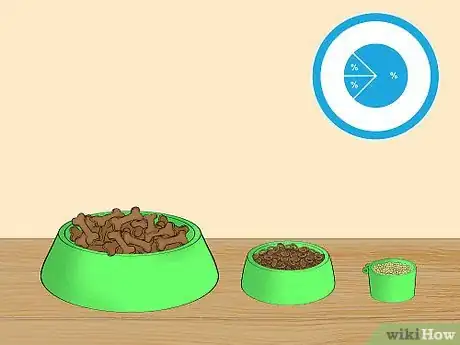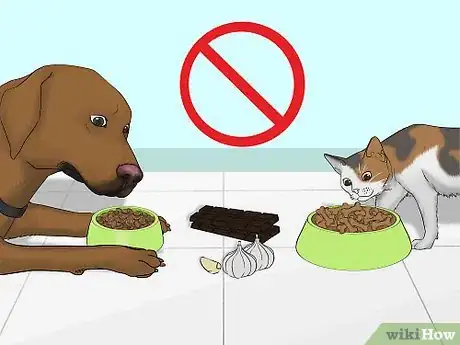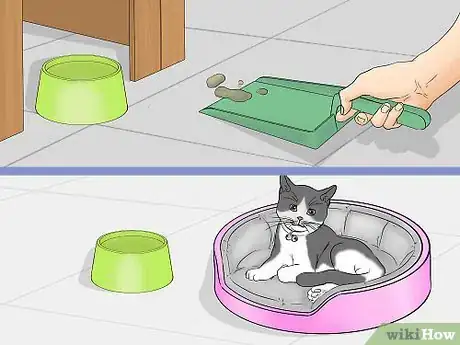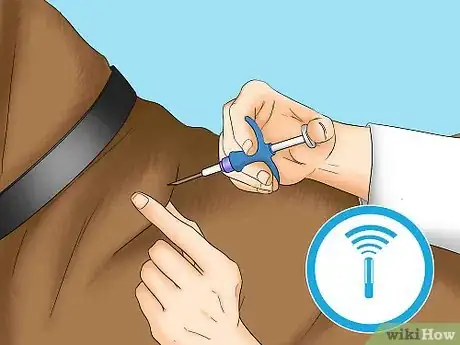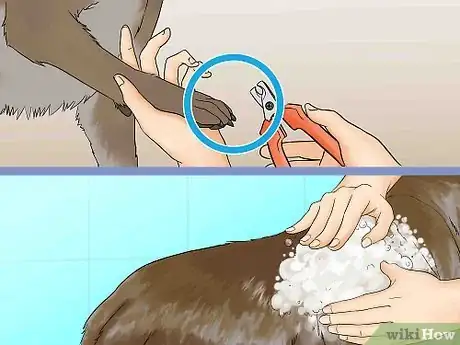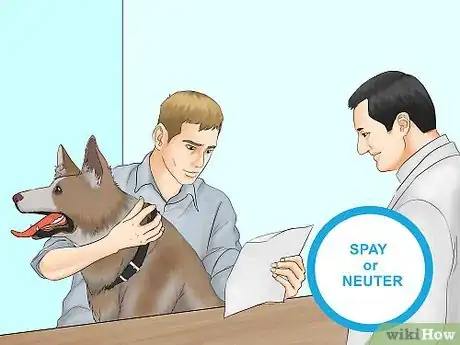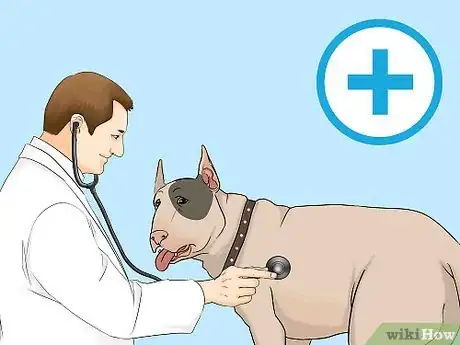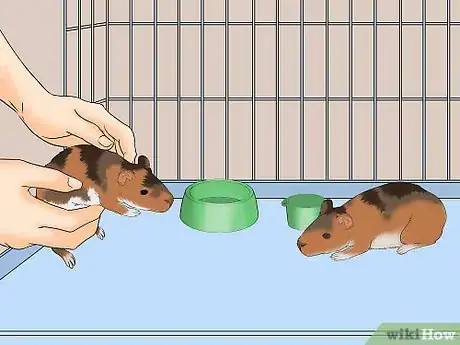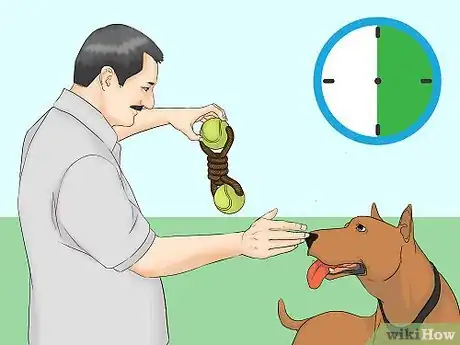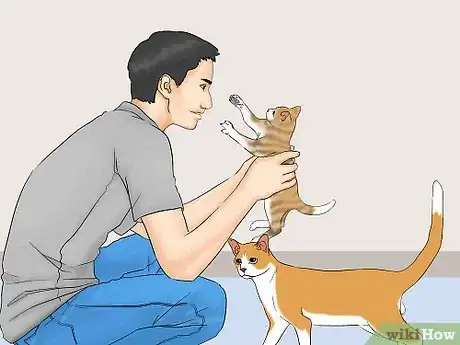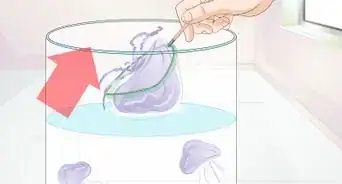This article was co-authored by Brian Bourquin, DVM and by wikiHow staff writer, Amy Bobinger. Brian Bourquin, better known as “Dr. B” to his clients, is a Veterinarian and the Owner of Boston Veterinary Clinic, a pet health care and veterinary clinic with three locations, South End/Bay Village, the Seaport, and Brookline, Massachusetts. Boston Veterinary Clinic specializes in primary veterinary care, including wellness and preventative care, sick and emergency care, soft-tissue surgery, dentistry. The clinic also provides specialty services in behavior, nutrition, and alternative pain management therapies using acupuncture, and therapeutic laser treatments. Boston Veterinary Clinic is an AAHA (American Animal Hospital Association) accredited hospital and Boston’s first Fear Free Certified Clinic. Brian has over 19 years of veterinary experience and earned his Doctor of Veterinary Medicine from Cornell University.
There are 10 references cited in this article, which can be found at the bottom of the page.
This article has been viewed 69,218 times.
Pets are a great way to add extra fun and affection into your everyday life, but they're a big commitment. While your pet's needs will depend largely on what type of animal you choose, there are some basics that apply to all pets. By taking care of your pet's nutrition and health, and by giving it the attention it needs, you can be a good pet owner!
Steps
Providing Proper Nutrition
-
1Provide your pet with a healthy, balanced diet. While your pet's diet will vary depending on what type of animal it is, it's important to feed it fresh food regularly. Choose food that's specific to your pet, and only give your pet treats occasionally. If you have any questions about what to feed your pet, consult your veterinarian.
- Sometimes diets can vary between different breeds or species of the same animal. For example, although they're both birds, a parrot and a macaw eat different diets in the wild, and their nutritional needs are also different in captivity.[1]
- Your pet's dietary needs may change as it ages. Talk to your vet about your pet's different life stages and what food is most appropriate for each one.
- Look for pet food that contains healthy ingredients you recognize.[2]
-
2Feed your pet the recommended amount of food at each meal. Be sure to follow the guidelines for how much your pet needs to eat each day. Overfeeding leads to obesity, which can cause other health problems. These could include heart disease, kidney problems, diabetes, and more.
- If you're not sure how much food you should be giving your pet, ask your veterinarian.
Tip: Learn how to body score your pet to assess its weight. This technique will vary by pet, such as if you have a dog, a cat, or a dwarf hamster.
Advertisement -
3Know what foods you should never give your pet. Certain foods are toxic to some animals, so be sure you know what you can and can't give your pet before you offer it a treat. For example, while it's perfectly fine to give your dog small bits of chicken or fish, you should never give them food containing chocolate or garlic, as these can be toxic.[3]
- Even some pet foods can be dangerous if fed to the wrong animal. For instance, you shouldn't feed cat food to a dog, or vice versa. Cat food contains high levels of taurine, which is necessary to a cat's diet but which can be dangerous to dogs in high doses. On the other hand, dog food doesn't contain the taurine your cat needs to be healthy.[4]
-
4Give your pet fresh water every day. All animals require water to live, although some will need much more than others. Regardless of the size of your pet, make sure that it always has access to fresh, clean water. Check or refill the water once or twice a day, and if they drink from a bowl, wash out the bowl every 2 to 3 days.
- If you have a pet that lives in an aquarium, change the water and clean the tank at least once a week.
Keeping Your Pet Healthy
-
1Provide a safe, clean environment for your pet. If you have a small animal, ensure that it has a safe cage with a secure door. If your pet is larger, it should have somewhere that it can go if it feels tired or scared, like a kennel for a dog or a barn stall for a horse. Keep your animal's living area, bedding, and food area neat by cleaning it every day.
- Make sure to pet-proof your home to make sure there isn't anything dangerous that could hurt your pet. Secure any chemicals or electrical cables, put fragile items somewhere secure so they can't get knocked over, and ensure your pet can't escape from your home.
- Do not leave poop in your pet's living area. Clean it up as soon as you see it, even if you have an outside animal. Some parasites in feces, including toxoplasmosis and roundworm, become more infectious over time. If you have a cat, remember to clean out its litter box daily. An unclean litter box may cause your cat to go outside of the litter box.[5]
-
2Have your pet microchipped or give it an ID tag in case it escapes. Even if you keep your pet indoors, there's always a chance it could accidentally get outside and get lost. If you have a microchip inserted at your vet, anyone who finds your pet can take it to be scanned, and the chip will let them know your contact information. Similarly, an ID tag should have your name and phone number so anyone who finds your pet can call you.[6]
- Collars with an ID tag can sometimes fall off, so a microchip is the most secure option.
- Remember to update the information on the microchip if your contact information changes!
- If you do opt for a collar with an ID tag, consider using a breakaway collar. That way, if it gets snagged on anything, your pet won't be choked.
-
3Groom your pet as needed. Your pet's grooming needs will depend on the type of animal it is. After all, a long-haired cat will need to be groomed very differently than a pig. However, it is important that you know what your animal's grooming needs are, and you attend to them as often as needed. This might mean combing or brushing your pet, bathing it, and clipping its nails, for instance.[7]
- Some animals NEVER need to be bathed. For example, a hamster will clean itself by rolling around in a bowl of sand.
- If your animal's teeth or beak grows continuously, make sure it has wooden chew toys to keep its teeth or beak filed down.
- In addition to being good for the animal, grooming provides bonding time between you and your pet. It will also give you a chance to spot any injuries or other unusual spots that develop.
-
4Provide your pet with toys if it likes them. Play time is very important to a lot of animals. Not only does it provide valuable exercise, but it also helps them hone their instinctive skills, such as hunting or problem-solving. Offer your pet different toys to see what it likes, then rotate the toys regularly to keep your pet interested in them.
- A hamster will enjoy having a wheel and a few wooden chew toys, for instance.
- If you have a horse, it might enjoy playing with a puzzle that dispenses treats.
- Be sure the toys you provide are recommended for your type of animal. For example, if you give a small cat toy to a large dog, it could swallow it and choke.
-
5Spay or neuter your pet if your vet recommends it. When you get your pet, talk to your vet about when you should get it spayed or neutered. While not all animals need this procedure, it's usually a good idea for common pets like cats and dogs. Often, your vet will prefer to perform this procedure while your pet is still young, although many adult animals can safely have the surgery as well.[8]
- Not only will spaying or neutering your pet prevent unwanted babies, but it will also keep your pet safe. When pets become preoccupied with mating, they will often roam away from home, where they could get lost, wander into the road, or encounter other animals. In addition, they could become engaged in competitive mating behaviors, which could lead to injury.
- Having your pet spayed or neutered may also improve its health in the long term.
- Neutering male kittens will help prevent unwanted spaying in the future.[9]
-
6Tend to your pet's medical needs. When you first get your pet, ask your vet if there are any vaccinations you should get for it. Even if your pet seems healthy, take it back to the vet once or twice a year for a wellness check, as well as anytime it seems sick or injured, or its behavior changes for no apparent reason.
- If your pet is unusually lethargic, stops eating, or develops unusual swelling, for instance, you should take it to the vet.
- Your vet can also advise you whether you should be giving your pet flea, tick, or heartworm medication.
Spending Time with Your Pet
-
1Spend some time researching your pet before you bring it home. Understand what your pet's exact needs will be, from its diet to its shelter. Then, make sure you have everything your pet will need before you bring it home. That way, you can spend your time bonding with your pet, rather than worrying about what supplies you'll need.[10]
- Think about your individual situation when you're choosing a pet. If you're very active and spend a lot of time outside, an energetic dog breed might be a great option for you. On the other hand, if you work long hours, a solitary reptile might fit your lifestyle better.
- When you're choosing your pet, remember that you're signing up for a commitment. You'll be responsible for your pet's food and water, grooming, training, and medical care for the rest of its life.
-
2Supervise the introduction of a new pet to any animals you already have. If you already have a pet and you're choosing a new one, make sure you give the animals plenty of time to get used to each other before you leave them alone together. Animals can sometimes be territorial, and they may fight. It can sometimes help to introduce them in a neutral area, like a room the pets aren't normally allowed to go into, or a new cage or tank for smaller animals and fish.[11]
- For example, to introduce 2 hamsters, you could place them in a clean tank with new bedding, so neither one will feel like it is "their" territory.
- If you already have a pet and you're choosing a new one, make sure you supervise any introductions and give the animals several days or even weeks to get used to each other before you leave them alone together.
-
3Socialize with your pet every day. In order to make sure your pet is comfortable around you, spend at least 30 minutes a day with it. This might mean playing, cuddling, grooming, or training, but the important thing is that you're consistently making time to let your pet know they're important to you.[12]
- Dogs and cats are especially sensitive to getting plenty of affection every day.
- Pets like snakes and turtles might not need to be handled every day. However, spending time around their habitat each day will make them more comfortable with your presence.
-
4Learn how your pet likes to be handled. Different pets like to be touched or picked up in different ways. Pay attention to your pet's body language while you're handling it. If it seems relaxed, it probably enjoys what you're doing. If it tenses up, tries to leave the area, or acts aggressive, you may have done something it didn't like. Try to avoid doing that again in the future.[13]
- Every pet's likes and dislikes will be different. For instance, some cats love getting belly rubs, but other cats will bite and scratch if you try to touch them on the stomach.
-
5Make sure your pet gets enough exercise. Many animals need to be taken out of their habitat and exercised. In some cases, this should be done daily, while in others it might only be a few times a week. Learn about your pet's exercise needs and make some extra time to give them a good workout when they need it.[14]
- For example, you might take your dog for a walk, have your cat chase a feather on a string, or place your hamster in an exercise ball.
Tip: When your pet starts to seem winded or tired, stop the exercise and let them rest.
-
6Be patient with your pet. Your pet won't always know what to do, and sometimes it will act out. This is usually a way to try to get attention, or because they're bored or aren't getting enough exercise. Sometimes, it might even be the result of a trauma they experienced in the past. Be patient and try to solve the underlying problem so you'll get along better with your pet![15]
- Never yell at, hit, or kick your pet. This will destroy the bond between you and your pet. Treating your pet this way may also lead your pet to become fearful or even aggressive.
Expert Q&A
-
QuestionIs it okay if 3 dogs sleep in bed with me? I have a king-sized bed.
 Pippa Elliott, MRCVSDr. Elliott, BVMS, MRCVS is a veterinarian with over 30 years of experience in veterinary surgery and companion animal practice. She graduated from the University of Glasgow in 1987 with a degree in veterinary medicine and surgery. She has worked at the same animal clinic in her hometown for over 20 years.
Pippa Elliott, MRCVSDr. Elliott, BVMS, MRCVS is a veterinarian with over 30 years of experience in veterinary surgery and companion animal practice. She graduated from the University of Glasgow in 1987 with a degree in veterinary medicine and surgery. She has worked at the same animal clinic in her hometown for over 20 years.
Veterinarian It's perfectly fine to sleep with your dogs if you choose to do so. As long as they all get along, their coats are kept clean, and you have a strong immune system...then go for it!
It's perfectly fine to sleep with your dogs if you choose to do so. As long as they all get along, their coats are kept clean, and you have a strong immune system...then go for it! -
QuestionMy dog has developed a habit of urinating on furniture. Why is he doing this?
 Pippa Elliott, MRCVSDr. Elliott, BVMS, MRCVS is a veterinarian with over 30 years of experience in veterinary surgery and companion animal practice. She graduated from the University of Glasgow in 1987 with a degree in veterinary medicine and surgery. She has worked at the same animal clinic in her hometown for over 20 years.
Pippa Elliott, MRCVSDr. Elliott, BVMS, MRCVS is a veterinarian with over 30 years of experience in veterinary surgery and companion animal practice. She graduated from the University of Glasgow in 1987 with a degree in veterinary medicine and surgery. She has worked at the same animal clinic in her hometown for over 20 years.
Veterinarian If the dog is an entire (not neutered) male, he may be marking his territory. Alternatively, there may be a breakdown in his house training and this may have led to bad habits.
If the dog is an entire (not neutered) male, he may be marking his territory. Alternatively, there may be a breakdown in his house training and this may have led to bad habits.
References
- ↑ http://vireo.ansp.org/bird_academy/bird_diets.html
- ↑ Brian Bourquin, DVM. Veterinarian. Expert Interview. 20 December 2019.
- ↑ https://www.akc.org/expert-advice/nutrition/human-foods-dogs-can-and-cant-eat/
- ↑ https://www.akc.org/expert-advice/nutrition/can-dogs-eat-cat-food/
- ↑ Brian Bourquin, DVM. Veterinarian. Expert Interview. 20 December 2019.
- ↑ https://www.gov.uk/get-your-dog-microchipped
- ↑ http://www.vetstreet.com/our-pet-experts/9-ways-to-be-an-even-better-pet-owner
- ↑ https://www.humanesociety.org/resources/why-you-should-spayneuter-your-pet
- ↑ Brian Bourquin, DVM. Veterinarian. Expert Interview. 20 December 2019.
- ↑ https://www.akc.org/expert-advice/lifestyle/responsible-dog-owner/
- ↑ https://www.petmd.com/cat/training/evr_ct_how-to-introduce-cats
- ↑ http://www.vetstreet.com/our-pet-experts/9-ways-to-be-an-even-better-pet-owner
- ↑ http://www.vetstreet.com/our-pet-experts/9-ways-to-be-an-even-better-pet-owner
- ↑ http://www.vetstreet.com/our-pet-experts/9-ways-to-be-an-even-better-pet-owner
- ↑ https://www.humanesociety.org/resources/bringing-your-new-dog-home
About This Article
If you want to be a good pet owner, talk to your vet about providing the pet with a healthy, balanced diet that’s right for its species and breed. Give your pet plenty of clean water, and change the water every day to ensure it’s fresh. Also, make sure to keep your pet’s living area clean, which may entail cleaning its food bowl and water bowl, washing its bedding, and picking up after the animal. Depending on the type of animal you have, you’ll also need to spend at least 30 minutes a day with your pet, either grooming, training, or playing with it. Keep reading for tips from our Veterinary co-author on how to provide for your pet’s medical needs!
